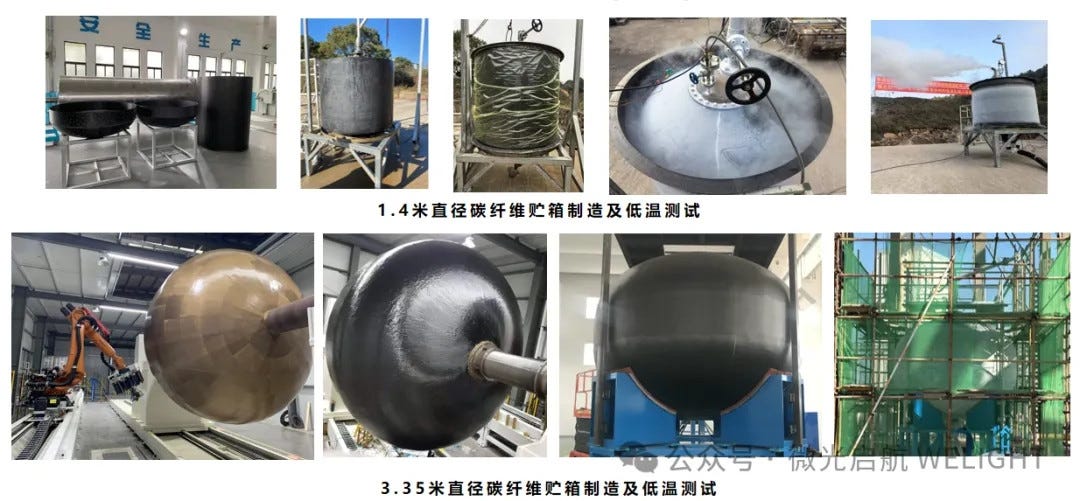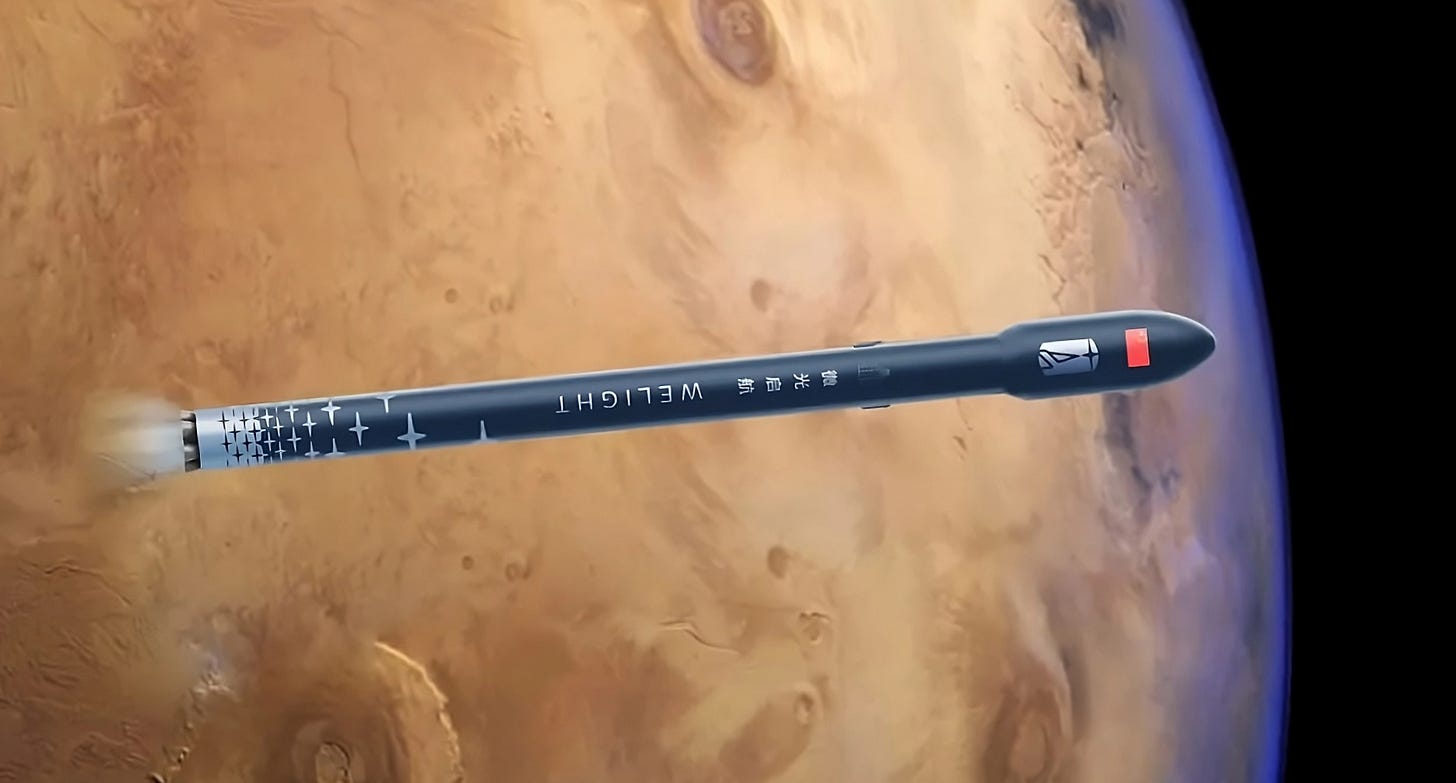New Reusable Rockets Aim Light and Large
In an increasingly crowded market, new enterprises think differently to compete.
As if China did not have enough privately-backed reusable rockets aimed at the commercial market under development, two new entrants, Welight (微光航行) and Arktech (星梭科技), are hoping their different choices will allow them to stand out.
A few weeks ago, Welight, full business name Glimmer Navigation Beijing Aerospace Technology Co Ltd (微光航行(北京)航天科技有限公司), revealed the design of its partially reusable Weiguang-1 (微光一号) two-stage launch vehicle, built from the light but strong carbon fiber and powered by full-flow staged-combustion engines. The rocket is stated as being 3.8 meters in diameter and 60 meters tall, with a fully-fuelled weight of 350,000 kilograms, thanks to a pursuit of “ultimate performance and cost-effectiveness”. For payload capacity, reusing the first-stage would have the rocket carry 9,000 kilograms to low Earth orbit or 7,000 kilograms to sun-synchronous orbit, while expending the rocket would see 11,000 kilograms sent to low Earth orbit and 9,000 kilograms to a sun-synchronous orbit.
Powering the light but high-performance rocket would be eleven Huaguang-1 (华光一号) engines generating 42 tons of thrust each, for a combined take-off thrust of 450 tons, on the first-stage, while a single vacuum optimized variant generates 52 tons of thrust. Huaguang-1 is planned to use a full-flow staged-combustion cycle while burning liquid methane and liquid oxygen to make Weiguang-1 as performant as possible.
So far, Welight has raised tens of millions of Yuan (at least 2.8 million United States Dollars1, as of September 2nd) to pursue initial development of its launch vehicle, having completed some cryogenic tests with carbon fiber propellant tank domes after producing a handful of test tanks. Confidence and inspiration in pursuing Weiguang-1’s carbon fiber design is said to have come from Firefly Aerospace’s Alpha, Rocket Lab’s Neutron, and proposed upgrades to Europe’s Ariane 6.

Specifics on how Weiguang-1 will be partially reusable are few, beyond statements of Huaguang-1 being reflown about twenty times. But based on a render of the rocket with Mars in the background, it appears that the launch vehicle will at least have grid fins to guide itself through the atmosphere.
At present, Welight plans to debut Weiguang-1 in 2028, with first-stage landing and reuse to follow by 2030.
Meanwhile, Arktech, business name Star Grid Technology Beijing Co Ltd (星格科技(北京)有限公司), is pursuing a somewhat conventional approach, except for the size of their first rocket. Dubbed Glacier-1 (冰川一号), the partially reusable stainless steel rocket stands at 92 meters tall while being 5 meters in diameter, alongside having two stages which are separated by hot-staging2 during ascent. A total of ten engines will power the rocket, one on the second-stage and nine on the first-stage, to lift its 1,080,000 kilograms fully-fuelled mass skyward. Arktech says Glacier-1 can carry 42,000 kilograms to low Earth orbit when expended, or 32,000 kilograms to low Earth orbit and 24,000 kilograms to sun-synchronous orbit when the first-stage is reused.
To power the giant rocket, Arktech is developing some incredibly powerful engines with its liquid methane and liquid oxygen burning Mammoth-1 (猛犸一号) series, weighing about 1,300 kilograms each. The engine is said to utilize a full-flow staged-combustion cycle to generate 163 tons of thrust, with a specific impulse of 326 seconds, at sea level (for 1,467 tons of thrust at liftoff), while a vacuum-optimized variant is set to generate 177 tons of thrust, with 354 seconds of specific impulse. To enable reuse, the engine is planned to throttle between forty and one hundred and ten percent of its rated thrust.
Exact details on how Arktech plans to pursue first-stage reuse have not been shared, but based on available renders, it appears that four grid-fins, to guide the booster during unpowered atmospheric descent, will remain in a deployed position throughout flight as at least one first-stage Mammoth-1 engine enables a soft touchdown via four landing legs. With design details and renders of the vehicle, those first-stage boosters look to be sixty to seventy meters in length. Despite that, the company is hoping to fly each booster twenty times.
Of course, to develop such a large rocket, a substantial amount of funding will be required. As of August 21st, Arktech says they have received tens of millions of Yuan (again, at least 2.8 million United States Dollars) in an angel funding round. For a launch vehicle of Glacier-1’s size and an engine of complex design like Mammoth-1, a lot more funding will likely be required.
As for the rationale of developing the massive Glacier-1 rocket, team members from Arktech, with the company boasting their Tsinghua University (清华大学)3 credentials, explained that they see enterprises globally currently focusing largely on medium-sized launch vehicles (like Falcon 9 and Zhuque-3), leaving room in the market for larger rockets. With that perceived gap in the market, Arktech designed Glacier-1 as the “ultimate form” of a commercial space launch solution, taking lessons learned from vehicles like SpaceX’s Starship-Super Heavy and developing hardware that their team believes is realistic without needing to pursue a smaller rocket.
Since its angel funding round, the company has begun work on Mammoth-1, completing a pre-combustion chamber fluid atomization test on September 1st. At the time of writing, no testing timelines or a debut flight target have been shared by Arktech.
Welight and Arkspace are the newest companies to join China’s increasingly crowded market of in-development reusable rockets, with both having to pursue something less developed by others to garner investor funding and possible customers. Other recent companies to do so as well are Nayuta Space (千亿航天) with its plans for bellyflopping first-stage boosters and Cosmoleap (大航跃迁), planning to catch boosters with recovery towers placed downrange of the launch site. The two new companies are also loosely following LandSpace Chief Executive Officer Zhang Changwu’s (张昌武) vision of a proliferation of full-flow staged-combustion engines to power reusable launch vehicles.
This would be assuming 20 million Yuan.
Where the engine on the second-stage lights during the last moments of first-stage powered ascent to ensure minimal losses in speed while heading into orbit.
China’s top university, based in Beijing.




